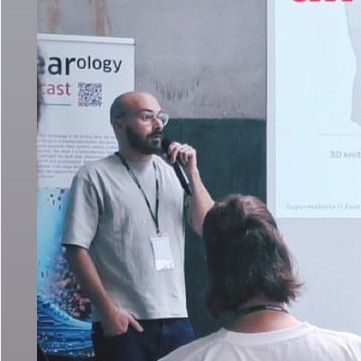Online Masterclass:
3D printing parametric textiles
Course features
-
6 live online workshops of 2.5 hours each. These will be recorded.
-
Level: Intermediate
Maximum 15 participants -
Study time: 15 hours, plus practice
Course overview
This class teaches you how to create spectaculair textiles for footwear and other applications using Grasshopper. It is the highly requested online version of the masterclass that Lorenzo Masini gave as part of our Footwearise event in 2024. The images you see on this page are of the textiles made by the participants of this class.
3D printing offers options for textiles that are not possible with any other technology, especially in combination with parametric design software such as Grasshopper, both from an aesthetic and functional perspective. Programming in Grasshopper allows you to design textiles based upon data and to make quick and endless variations.
You will need beginner knowledge of Grasshopper for this course. This is why we are offering a special discount on our Grasshopper for Footwear course. If you do not have any knowledge of Grasshopper, we advise you to do this course first and then jump into this parametric textiles course. We now have a super attractive bundle for both courses for only 499 euros!
Join our 3D printing live classes from August 11-14
To celebrate that we have settled into our new lab in Alicante, we are organizing a 4-day online 3D Print Fest. We will launch several new instructional videos for our 3D printing courses and will present 4 live classes, including guest speakers, each covering a different topic. We will offer you an exclusive sneak peek into our own 3D print lab and how we work there.
It is an ideal occasion to ask any questions you have on 3D printing, share your experiences and meet other creatives that are 3D printing footwear. Our 3D Print Fest is open to anyone who is enrolled in one (or more) of our 3D printing courses.
LIVE CLASS SCHEDULE:
Monday, August 11, 7:30 PM CEST - 9 PM CEST: 3D PRINTING MATERIALS
We will be talking about which materials we use, their pros and cons, the slicer settings, including relatively new materials such as Balena.
Tuesday, August 12, 7:30 PM CEST - 9 PM CEST: DESIGN FOR 3D PRINTING
In this class we will discuss some clear guidelines for design, making sure your designs are easy to print on an FDM machine. We will discuss design for both vertical and horizontal printing.
Wednesday, August 13, 7:30 PM CEST - 9 PM CEST: SLICING QUESTIONS
In this class you can ask all your questions on slicing. We will give a demo on how to slice a model with different slicer settings in different areas,
Thursday, August 14, 7:30 PM CEST - 9 PM CEST: EXPERIENCE EXCHANGE
This time we speak to several other creatives that are also printing shoes or textiles, sharing their successes and failures. Please join in!
Links to the classes will be shared with all participants in any of our 3D printing classes and our 3D printing bundle. The classes are not open to people who are not enrolled in any of our 3D printing courses.
Not enrolled yet? Then choose your course below or use the special offer we have for our 3D Printing Pro Bundle that includes all our 3D printing courses.
It is an ideal occasion to ask any questions you have on 3D printing, share your experiences and meet other creatives that are 3D printing footwear. Our 3D Print Fest is open to anyone who is enrolled in one (or more) of our 3D printing courses.
LIVE CLASS SCHEDULE:
Monday, August 11, 7:30 PM CEST - 9 PM CEST: 3D PRINTING MATERIALS
We will be talking about which materials we use, their pros and cons, the slicer settings, including relatively new materials such as Balena.
Tuesday, August 12, 7:30 PM CEST - 9 PM CEST: DESIGN FOR 3D PRINTING
In this class we will discuss some clear guidelines for design, making sure your designs are easy to print on an FDM machine. We will discuss design for both vertical and horizontal printing.
Wednesday, August 13, 7:30 PM CEST - 9 PM CEST: SLICING QUESTIONS
In this class you can ask all your questions on slicing. We will give a demo on how to slice a model with different slicer settings in different areas,
Thursday, August 14, 7:30 PM CEST - 9 PM CEST: EXPERIENCE EXCHANGE
This time we speak to several other creatives that are also printing shoes or textiles, sharing their successes and failures. Please join in!
Links to the classes will be shared with all participants in any of our 3D printing classes and our 3D printing bundle. The classes are not open to people who are not enrolled in any of our 3D printing courses.
Not enrolled yet? Then choose your course below or use the special offer we have for our 3D Printing Pro Bundle that includes all our 3D printing courses.
Write your awesome label here.
Course format
Course Lessons
Course Schedule
WEEK 1:
WEEK 2: Stochastic textures
WEEK 3: Auxetic textures
What do you need to join this course?
These things are not included in the course price!
Computer
- Laptop or desktop - a tablet might not be powerful enough - either PC or Mac
- Mouse
3D printer
FDM 3D printer that works with filament and has direct drive, or you should have access to such a printer. Download a list of suitable 3D printers for textiles here!
filament dryer
Flexible filaments will need to be dried in order to achieve the best results. To start we recommend the SunLu S2 Dryer, so you can guide your filament from the dryer straight into the printer. It costs 40 euros or less.
3D Printing Materials
Software
You will need Rhino 8, which includes Grasshopper. You will install all necessary plugins during the class. If you do not know how to use Grasshopper, then please follow our course Grasshopper for Footwear first.
Time for homework
You will make all Grasshopper definitions in class, but the 3D printing will have to happen after, so you will need to calculate with the printing time as well. This is also why there is some time between the classes.
Meet your instructor:


